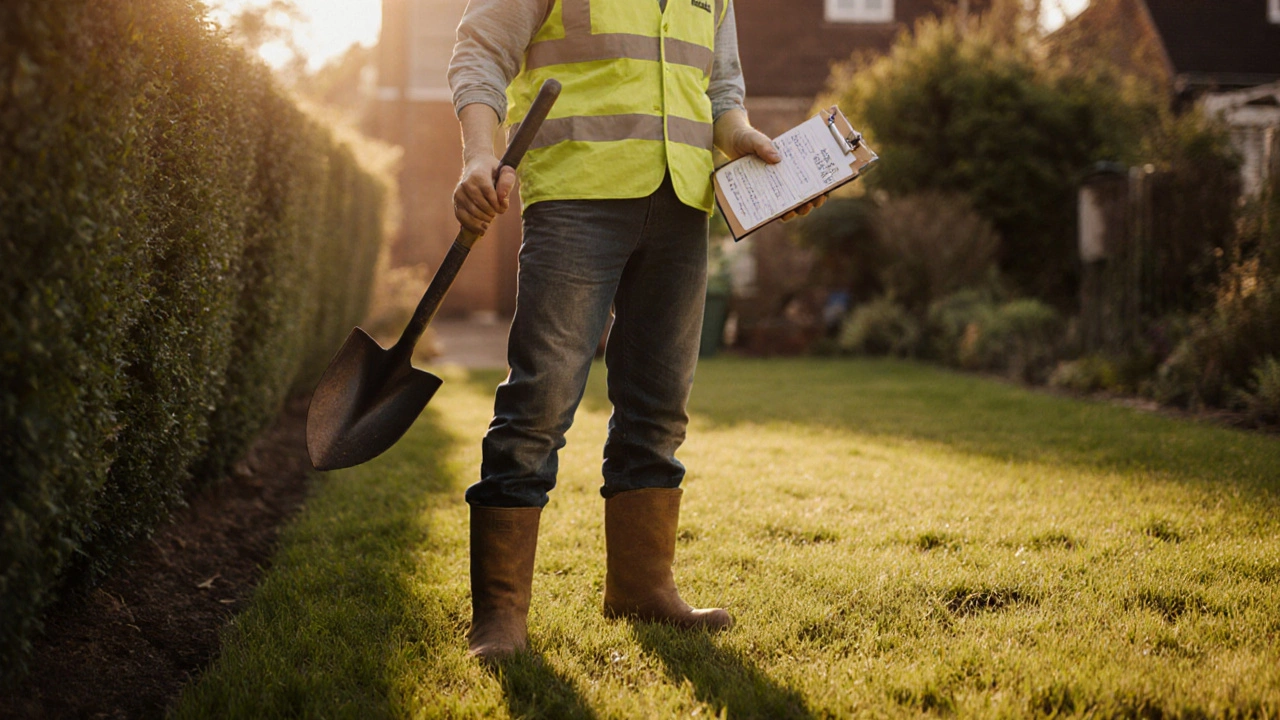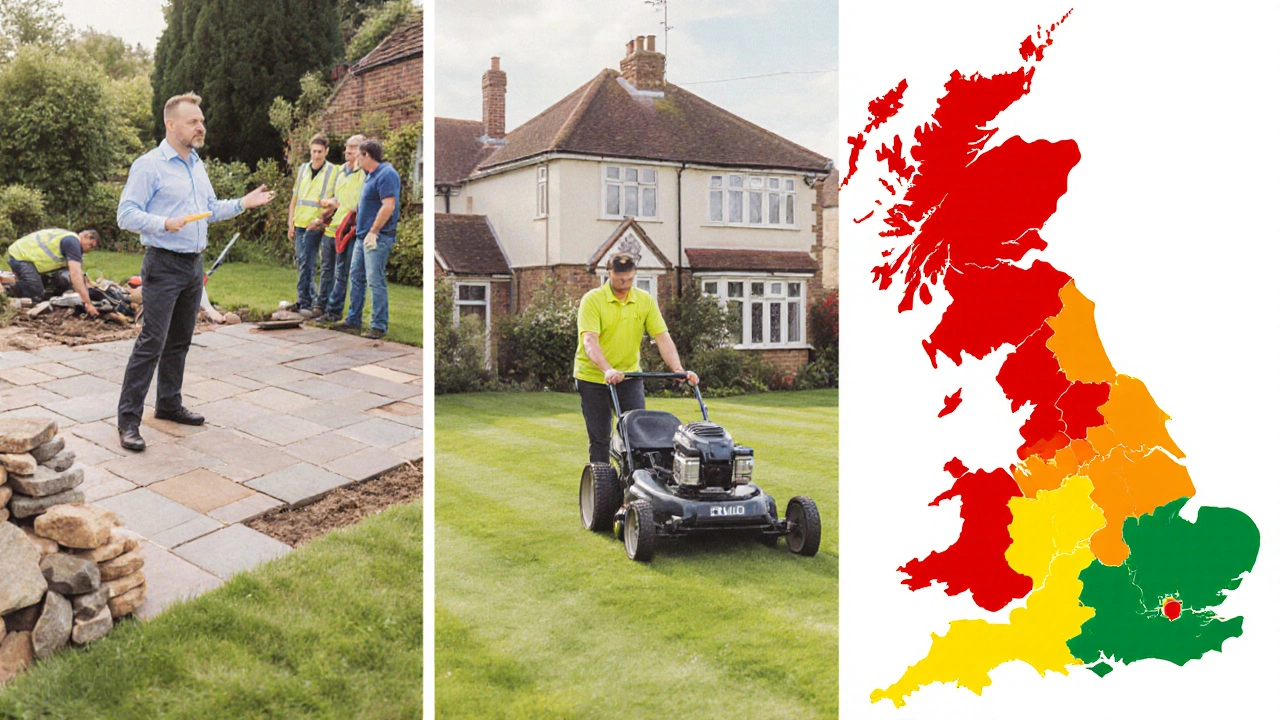Landscaper Salary: How Much Can Top Landscapers Earn in the UK?

Landscaper Earnings Calculator
Calculate Your Potential Earnings
Enter your details to estimate your hourly and annual income based on UK industry standards.
Estimated Earnings
Hourly Rate
£0.00
Annual Salary (Full-Time)
£0.00
When you hear someone say they make a landscaper salary that turns heads, you wonder what the numbers actually look like. In the UK, pay for landscaping professionals ranges from modest starter wages to six‑figure earnings for specialists running large crews or niche businesses. This guide breaks down the current pay landscape, explains why the numbers differ, and shows you how to position yourself for the highest possible earnings.
Landscaper is a person who designs, installs, and maintains outdoor spaces such as gardens, parks, and commercial grounds. The role can be full‑time employee, contract worker, or self‑employed business owner, and each employment model brings its own pay structure.
Understanding the Landscape of Pay
Pay in landscaping isn’t a single figure; it’s a spectrum shaped by four main pillars: experience level, employment type, geographic location, and the services you offer. The UK construction sector reports that the average hourly rate for a skilled tradesperson in 2024 sits around £15, but landscapers who combine design expertise with high‑value hard‑scaping can command double or triple that rate.
Factors That Drive Top Earnings
- Landscape Contractor is a business entity that manages larger projects, hires crews, and contracts with clients for comprehensive outdoor works. Contractors inherit the profit margin of each job, so managing multiple sites simultaneously multiplies income.
- Lawn Care is a service focused on regular maintenance tasks such as mowing, edging, fertilising, and weed control. High‑frequency contracts provide stable cash flow, especially in affluent suburbs.
- Hardscaping is a the installation of non‑plant elements like patios, retaining walls, water features, and stone pathways. These projects carry higher material costs, which translate into higher labour rates.
- Specialised certifications-such as a City & Guilds Level 3 in Landscape and Horticultural Management-signal expertise and allow you to charge premium fees.
- The rise of sustainable design (rain gardens, native planting) has created a niche market where clients are willing to pay a premium for eco‑friendly solutions.
Typical Salary Ranges by Experience
| Experience | Hourly Rate (Gross) | Annual Salary (Full‑Time) | Typical Role |
|---|---|---|---|
| Apprentice (0‑2years) | £9-£11 | £18,000-£22,000 | Grounds‑keeper, junior crew member |
| Qualified Operative (3‑5years) | £12-£15 | £24,000-£30,000 | Site supervisor, design assistant |
| Senior Specialist (6‑10years) | £16-£22 | £32,000-£45,000 | Project lead, design consultant |
| Owner‑Operator / Contractor (10+years) | £25-£45 (incl. profit) | £45,000-£120,000+ | Business owner, senior contractor |

Regional Pay Differences Across the UK
Location matters. London and the South‑East top the pay chart because land values and client budgets are higher. Meanwhile, the North‑East and Wales tend to offer lower average rates but also experience less competition, which can be advantageous for independent contractors.
| Region | Average Hourly Rate | Key Market Drivers |
|---|---|---|
| London & South‑East | £30-£45 | High‑value residential projects, commercial estates |
| South‑West | £22-£30 | Coastal properties, luxury gardens |
| Midlands | £18-£25 | Urban regeneration, mixed‑use developments |
| North‑East & Wales | £14-£20 | Public parks, council contracts |
How Self‑Employment Affects Take‑Home Pay
Most top‑earning landscapers are self‑employed. This model offers freedom but brings tax and insurance responsibilities. The UK’s National Minimum Wage is a legal floor for hourly pay that applies to employees, not typically to contractors. However, contractors must still account for Income Tax, Class2 and Class4 National Insurance, and often a higher rate of Business Rates if they operate from a dedicated workshop.
Self‑employed landscapers usually set aside 25‑30% of gross revenue for taxes and pension contributions. After these deductions, a contractor earning £60,000 gross may walk away with approximately £42,000 net, which still outpaces most employee figures.
The CITB is a government‑linked body that offers training and apprenticeships for the construction sector, including landscaping. Engaging with CITB courses can unlock levy funding and improve credibility, which in turn lifts billable rates.

Boosting Your Earnings: Proven Strategies
- Specialise in high‑margin services. Clients consistently pay more for stone patios, outdoor kitchens, and custom water features than for routine lawn mowing.
- Obtain relevant qualifications. A City & Guilds Level3 or a BTEC in Landscape Construction can justify a 20‑30% rate increase.
- Build a portfolio of photographed before‑and‑after projects. Visual proof attracts premium commercial contracts.
- Leverage digital marketing. A well‑optimised website, Google My Business listing, and Instagram showcase can double inbound leads within six months.
- Bundle services. Offer a “maintenance package” that includes seasonal planting, irrigation checks, and hard‑scape inspections for a fixed annual fee.
- Target affluent neighborhoods. Research property values via the Land Registry; higher property values correlate with larger project budgets.
- Join a professional association such as the British Association of Landscape Industries (BALI). Membership provides networking opportunities that lead to larger contracts.
Checklist for Maximising Landscape Income
- ✅ Have at least one advanced certification (e.g., City & Guilds Level3).
- ✅ Offer at least two high‑margin hard‑scaping services.
- ✅ Maintain a portfolio with high‑resolution images and client testimonials.
- ✅ Keep a spreadsheet tracking gross revenue, tax set‑aside, and net profit.
- ✅ Review regional market rates every quarter and adjust quotes accordingly.
- ✅ Renew insurance policies annually to ensure adequate coverage for public liability and tools.
- ✅ Schedule quarterly networking events with local architects, builders, and property developers.
Frequently Asked Questions
What is the average hourly rate for a UK landscaper?
For a qualified operative with 3-5years experience, the typical hourly rate sits between £12 and £15, translating to roughly £24,000-£30,000 per year on a full‑time basis.
Can self‑employed landscapers earn six figures?
Yes. Owners who combine design consulting, large‑scale hard‑scaping, and maintenance contracts can surpass £100,000 gross annually, especially in the South‑East where project values are highest.
How does the National Minimum Wage affect landscapers?
The Minimum Wage sets the floor for employee rates. Contractors hiring staff must pay at least the current rate (£10.42 per hour for workers 23 and over in 2025). Independent landscapers can set higher fees based on skill and market demand.
Do certifications really boost pay?
Industry data from the Construction Industry Training Board (CITB) shows that certified landscapers command 15‑25% higher rates than peers without formal qualifications.
What are the biggest tax considerations for a self‑employed landscaper?
You’ll need to budget for Income Tax, Class2 and Class4 National Insurance, and possibly VAT if turnover exceeds £85,000. Setting aside 25‑30% of gross income is a common rule of thumb to avoid cash‑flow surprises.
Write a comment